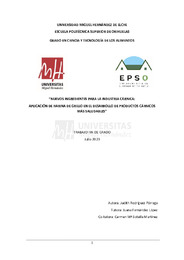Por favor, use este identificador para citar o enlazar este ítem:
https://hdl.handle.net/11000/30222Registro completo de metadatos
| Campo DC | Valor | Lengua/Idioma |
|---|---|---|
| dc.contributor.advisor | Fernández López, Juana | - |
| dc.contributor.advisor | Botella Martínez, Carmen María | - |
| dc.contributor.author | Rodríguez Párraga, Judith | - |
| dc.contributor.other | Departamentos de la UMH::Tecnología Agroalimentaria | es_ES |
| dc.date.accessioned | 2023-11-21T08:04:51Z | - |
| dc.date.available | 2023-11-21T08:04:51Z | - |
| dc.date.created | 2023-07 | - |
| dc.identifier.uri | https://hdl.handle.net/11000/30222 | - |
| dc.description.abstract | Existe una demanda creciente por el consumo de alimentos ricos en proteína, también focalizada en el consumo de proteína de origen alternativo. En este trabajo se aplicó harina de grillo común (Acheta domesticus) a un producto cárnico tipo hamburguesa a fin de enriquecerlo proteicamente, obteniendo 3 formulaciones diferentes donde variaba el porcentaje adicionado de harina. Se caracterizaron química y fisicoquímicamente, se determinaron sus propiedades tecno-funcionales y sus propiedades de cocción, presentando los mejores resultados para la formulación F 20%, la de mayor porcentaje adicionado (20% de harina de grillo). En cambio, no ocurrió igual a nivel sensorial, donde fue la peor valorada. La harina de grillo presenta ventajas tanto nutricionales como medioambientales, en relación con el cambio climático y la cría de animales de abasto, dado que requiere menor contenido de agua para su cría y produce menores emisiones de CO2 que los animales de abasto. Se trata de un producto más sostenible y saludable, ya que también supone una mejora en el perfil lipídico del producto en comparación con un producto cárnico tipo convencional, prevaleciendo los ácidos grasos poliinsaturados, la proteína y fibra como macronutrientes y Mg, Fe y Zn como micronutrientes. En conclusión, la harina de grillo podría ser un nuevo ingrediente en la industria cárnica a fin de obtener análogos cárnicos más saludables, adaptándose a la demanda de los consumidores y contribuyendo al desarrollo e innovación de la industria cárnica, permitiendo un crecimiento de mercado óptimo. | es_ES |
| dc.description.abstract | There is a growing demand for protein-rich foods, also focused on the consumption of protein of alternative origin. In this study, common cricket (Acheta domesticus) flour was applied to a hamburger-type meat product in order to enrich it with protein, obtaining three different formulations in which the percentage of flour added varied. They were chemically and physico-chemically characterised, their techno-functional properties and their cooking properties were determined, with the best results for formulation F 20%, the one with the highest percentage added (20% cricket flour). On the other hand, the same did not occur at the sensory level, where it was the worst evaluated. Cricket meal has both nutritional and environmental advantages in relation to climate change and the rearing of food animals, as it requires less water content for rearing and produces lower CO2 emissions than food animals. It is a more sustainable and healthier product, as it also means an improvement in the lipid profile of the product compared to a conventional meat product, with polyunsaturated fatty acids, protein and fibre as macronutrients and Mg, Fe and Zn as micronutrients. In conclusion, cricket flour could be a new ingredient in the meat industry in order to obtain healthier meat analogues, adapting to consumer demand and contributing to the development and innovation of the meat industry, allowing optimal market growth. | es_ES |
| dc.format | application/pdf | es_ES |
| dc.format.extent | 50 | es_ES |
| dc.language.iso | spa | es_ES |
| dc.publisher | Universidad Miguel Hernández de Elche | es_ES |
| dc.rights | info:eu-repo/semantics/openAccess | es_ES |
| dc.rights | Attribution-NonCommercial-NoDerivatives 4.0 Internacional | * |
| dc.rights.uri | http://creativecommons.org/licenses/by-nc-nd/4.0/ | * |
| dc.subject | Grillo | es_ES |
| dc.subject | Sostenibilidad | es_ES |
| dc.subject | Saludable | es_ES |
| dc.subject.other | CDU::6 - Ciencias aplicadas::66 - Ingeniería, tecnología e industria química. Metalurgia::663/664 - Alimentos y nutrición. Enología. Aceites. Grasas | es_ES |
| dc.title | Nuevos ingredientes para la industria cárnica: aplicación de harina de grillo en el desarrollo de productos cárnicos más saludables | es_ES |
| dc.type | info:eu-repo/semantics/bachelorThesis | es_ES |

Ver/Abrir:
TFG Rodríguez Párraga, Judith.pdf
2,03 MB
Adobe PDF
Compartir:
 La licencia se describe como: Atribución-NonComercial-NoDerivada 4.0 Internacional.
La licencia se describe como: Atribución-NonComercial-NoDerivada 4.0 Internacional.
.png)